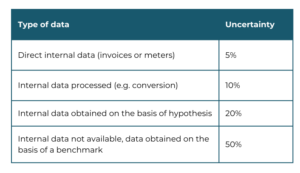
Activity data
The activity data from a company corresponds to the quantity of a specific product or service (e.g., amount of kWh of electricity used, numbers of cars, tons of product etc.).
The principle of GHGs emissions quantification for an organization is simple, for each emission source, the following calculation is performed.

The activity data from a company corresponds to the quantity of a specific product or service (e.g., amount of kWh of electricity used, numbers of cars, tons of product etc.).

The emissions factor is specific to each activity data and therefore allows to convert the activity data into the quantity of CO2 equivalent emitted (for example: Burning 1 litre of petrol=2.3 kg CO2e).
These emission factors are available in various carbon databases such as, among others, the ADEME database or the IPCC.
The uncertainty of the carbon footprint corresponds to the margin of error between the estimate and the actual value of the carbon footprint.
The lower the uncertainty, the narrower the range. Conversely, greater uncertainty means a wider range.
The uncertainty of each emission item comes from both the activity data and the emission factors.
The uncertainties associated with activity data are allocated by the user of the tool or by the tool itself, depending on the quality of the data provided.
To guide the choice, the uncertainty of activity data can be standardised as follows.

We use several emission factor databases to provide users with as exhaustive a list as possible.
The uncertainties associated with the emission factors (U FE ) are directly defined by the Bilan Carbone® methodology or the GHG protocol methodology.
The total uncertainty of an emission source is defined by:

For the final balance, the overall uncertainty is obtained using the following formula:
